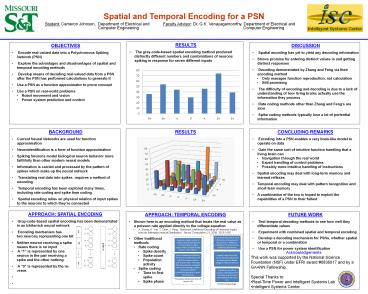Poster Template PowerPoint PPT Presentation
1 / 1
Title: Poster Template
1
Spatial and Temporal Encoding for a PSN
Student Cameron Johnson, Department of
Electrical and Computer Engineering
Faculty Advisor Dr. G.K. Venayagamoorthy,
Department of Electrical and Computer
Engineering
- RESULTS
- The gray-code-based spatial encoding method
produced distinctly different numbers and
combinations of neurons spiking in response for
seven different inputs
- OBJECTIVES
- Encode real-valued data into a Polychronous
Spiking Network (PSN) - Explore the advantages and disadvantages of
spatial and temporal encoding methods - Develop means of decoding real-valued data from
a PSN after the PSN has performed calculations to
generate it - Use a PSN as a function approximator to prove
concept - Use a PSN on real-world problems
- Robot movement and vision
- Power system prediction and control
- DISCUSSION
- Spatial encoding has yet to yield any decoding
information - Shows promise for entering distinct values in and
getting distinct responses - Decoding demonstrated by Zhang and Feng via
their encoding method - Only manages function reproduction, not
calculation - Still promising
- The difficulty of encoding and decoding is due
to a lack of understanding of how living brains
actually use the information they process - Rate coding methods other than Zhang and Fengs
are slow - Spike coding methods typically lose a lot of
portential information
- BACKGROUND
- Current Neural Networks are used for function
approximation - Neuroidentification is a form of function
approximation - Spiking Neurons model biological neuron behavior
more faithfully than other modern neural models - Information is carried and processed by the
pattern of spikes which make up the neural
network - Translating real data into spikes requires a
method of encoding - Temporal encoding has been explored many times,
including rate coding and spike time coding - Spatial encoding relies on physical relation of
input spikes to the neurons to which theyre
connected
RESULTS
- CONCLUDING REMARKS
- Encoding into a PSN enables a very brain-like
model to operate on data - Gain the same sort of intuitive function
handling that a living brain can - Navigation through the real world
- Expert handling of control problems
- Possibly more intuitive handling of instructions
- Spatial encoding may deal with long-term memory
and learned reflexes - Temporal encoding may deal with pattern
recognition and short-term memory - A combination of the two is hoped to exploit the
capabilities of a PSN to their fullest
- APPROACH SPATIAL ENCODING
- Gray-code-based spatial encoding has been
demonstrated in an Izhikevich neural network - Encoding mechanism has
- two neurons representing one bit
- Neither neuron receiving a spike
- means there is no input
- A 1 is represented by one
- neuron in the pair receiving a
- spike and the other nothing.
- A 0 is represented by the re-
- verse.
- APPROACH TEMPORAL ENCODING
- Shown here is an encoding method that treats the
real value as a poisson rate applied directly to
the voltage equation - X. Zhang, G. You, T. Chen, J. Feng. Maximum
Likelihood Decoding of Neuronal Inputs from an
Interspike Interval Distribution. Neural
Computation 21, 2009, 3079-3105. - Other traditional
- methods
- Rate coding
- Spike density
- Spike count
- Population
- activity
- Spike coding
- Time to first
- spike
- Spike phase
- FUTURE WORK
- Test temporal decoding methods to see how well
they differentiate values - Experiment with combined spatial and temporal
encoding - Develop a decoding mechanism for PSNs, whether
spatial or temporal or a combination - Use a PSN for power system identification
- Acknowledgements
- This work was supported by the National Science
Foundation (NSF) under EFRI award 0836017 and by
a GAANN Fellowship. - Special Thanks to
- Real-Time Power and Intelligent Systems Lab
- Intelligent Systems Center

